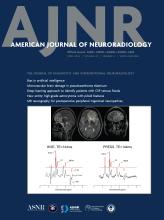This article requires a subscription to view the full text. If you have a subscription you may use the login form below to view the article. Access to this article can also be purchased.
Abstract
BACKGROUND AND PURPOSE: Predicting long-term clinical outcome in acute ischemic stroke is beneficial for prognosis, clinical trial design, resource management, and patient expectations. This study used a deep learning–based predictive model (DLPD) to predict 90-day mRS outcomes and compared its predictions with those made by physicians.
MATERIALS AND METHODS: A previously developed DLPD that incorporated DWI and clinical data from the acute period was used to predict 90-day mRS outcomes in 80 consecutive patients with acute ischemic stroke from a single-center registry. We assessed the predictions of the model alongside those of 5 physicians (2 stroke neurologists and 3 neuroradiologists provided with the same imaging and clinical information). The primary analysis was the agreement between the ordinal mRS predictions of the model or physician and the ground truth using the Gwet Agreement Coefficient. We also evaluated the ability to identify unfavorable outcomes (mRS >2) using the area under the curve, sensitivity, and specificity. Noninferiority analyses were undertaken using limits of 0.1 for the Gwet Agreement Coefficient and 0.05 for the area under the curve analysis. The accuracy of prediction was also assessed using the mean absolute error for prediction, percentage of predictions ±1 categories away from the ground truth (±1 accuracy [ACC]), and percentage of exact predictions (ACC).
RESULTS: To predict the specific mRS score, the DLPD yielded a Gwet Agreement Coefficient score of 0.79 (95% CI, 0.71–0.86), surpassing the physicians’ score of 0.76 (95% CI, 0.67–0.84), and was noninferior to the readers (P < .001). For identifying unfavorable outcome, the model achieved an area under the curve of 0.81 (95% CI, 0.72–0.89), again noninferior to the readers’ area under the curve of 0.79 (95% CI, 0.69–0.87) (P < .005). The mean absolute error, ±1ACC, and ACC were 0.89, 81%, and 36% for the DLPD.
CONCLUSIONS: A deep learning method using acute clinical and imaging data for long-term functional outcome prediction in patients with acute ischemic stroke, the DLPD, was noninferior to that of clinical readers.
ABBREVIATIONS:
- AC
- Agreement Coefficient
- ACC
- accuracy
- ±1ACC
- mRS accuracy within ±1 score
- AIS
- acute ischemic stroke
- AUC
- area under the curve
- DL
- deep learning
- DLPD
- deep learning–based predictive model
- IQR
- interquartile range
- MAE
- mean absolute error
- ROC
- receiver operating characteristic
- © 2024 by American Journal of Neuroradiology







